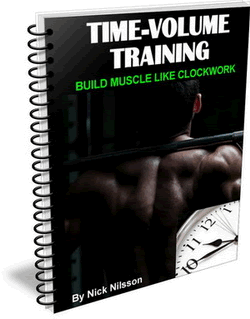The push-up (also known as the press-up)...it's likely the first exercise you think of when you think of bodyweight training.
It's also one of the BEST bodyweight training exercises you can do.
Bodyweight exercises have been shown to increase muscle fiber activation over their free weight and machine counterparts. This means a push-up (assuming equal resistance) would build muscle and strength more effectively than a bench press or machine press.
The main problem with the push-up is that, as great as it is, you are limited by your own bodyweight... there's only so much of you to go around. Granted there are plenty of variations of the push-up you can use to increase the resistance of the exercise without adding extra weight, but the most straightforward way to increase the resistance is to simply add resistance.
And that gives you several options, several of which require a partner to help you.
1. Have a partner push down or sit on your back.
2. Have a partner load weight plates onto your back.
3. Figure out how to load weight plates or a sandbag onto your back
4. Use a training band over your back and in your hands.
Since I train alone in my basement, I don't have the option of a partner to help me. I've loaded a sandbag on my back, but there is a limit to how heavy of a sandbag you can work with in that fashion. I've also use a training band over the back, which gives nice resistance at the top but zero at the bottom.
To solve all those problems, I now use THIS version... the Weighted Push-Up done with a dip belt, set up in the power rack.
It allows you to very easily set yourself up with as much weight as you can possibly use to load the push-up exercise, which helps with building maximal strength in a way that normal, high-rep push-ups simply can't.
|
To do this exercise, you'll need a dip belt and a power rack. Set the safety rails in the power to two different heights...one at hip level, the other at knee level. You'll be setting your feet on the lower one and your hands on the upper one.
The reason we're using two different heights will be apparent when you see the body position of the exercise.
Once you've got your rails set, lean some plates up against the rack uprights and get the dip belt on, with the chain strung through the center. In the demo video, I start off using four 45 lb plates...I only got 2 reps with it (I wanted to challenge myself to see how much weight I could do on it) so I reduced the weight to 3 plates on the next set, then 2 plates on the final set.
The dip belt should be on your lower back as you get into position.

With the plates hanging down, waddle into the middle of the rack (you can't walk normally with weight plates hanging down), lean forward and rest the plates on the ground. This is the next important step...

Shift the belt up higher on your back, so it's just below your shoulder blades rather than on your lower back. This is important in order to move the resistance closer to the arms (that are actually doing the work).
If the belt is on your lower back, the movement becomes more awkward and it pulls down on the lower back too much. The higher belt location gives you more support and allows for greater resistance.

Now get into position, setting your hands on the upper rail at your normal push-up width (for me, it was with my hands right up against the uprights since my rack isn't tremendously deep) and setting your feet on the lower rail.

You're ready to begin!
Now here's the reason one rail is lower than the other...we want to keep the torso horizontal during the movement so the belt doesn't slide up or down the back. We also want to keep a somewhat piked body position, as this engages the abs and takes pressure off the lower back.
If you try and keep a straight body position with 180 lbs hanging off you, it will fold you like a burrito. Your body will naturally assume this piked position at the top.

Lower yourself down, just like you would in a regular push-up.
As you come down, you will lose some of the pike position, which is totally fine as the weight will actually be pulling forward a bit, taking pressure off the lower back anyway.
Come down until you touch your chest to the bar then push back up, increasing the pike-ness of your body as you come up to protect the back. This does happen pretty naturally, so you probably won't even need to consciously do it.

The first time you try this weighted push-up technique, start with light weight...don't jump right to your maximum. Get an idea of how to do it THEN you can start sensibly increasing the weight from there.
One difference between this exercise and the regular floor push-up is the path of your body...it's not a straight up and down movement. This is actually a very good thing as the angle and arc of the push engages the upper chest more than the lower chest (because you're pushing up and back, away from the safety rail).
If you're strong on the push-up and have been looking for a way to get some serious resistance with it, this is a GREAT way to do it. You can load it to the maximum without need a training partner to help you.
This is an extremely effective way to develop the pecs with a bodyweight plus weight exercise, through increased muscle fiber activation.
For increased loading on the chest without extra resistance, try the One-Arm Bench Push-Up exercise.
![]()
More From Fitstep.com
| Compound Exercise Overload Training for Mass | |
| Shred Your Back and Chest With a Superset of In-Set Supersets | |
| Where Do I Start With Fitness? Start Here. | |
| This Killer Core Exercise Will Leave You Crawling |
Share This Page...
---
Home -> Exercise Library -> Chest Exercises -> Dip Belt Weighted Push-Ups



